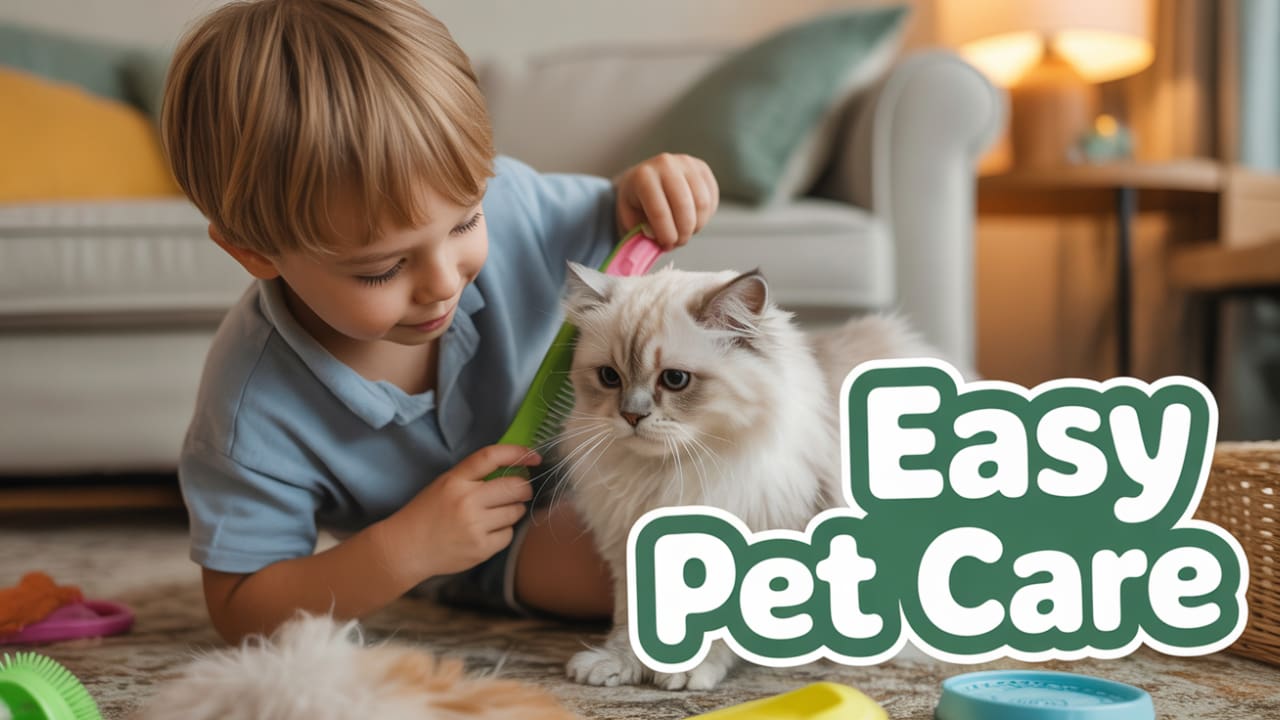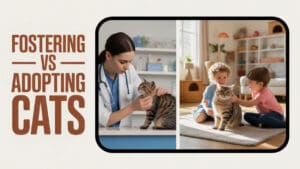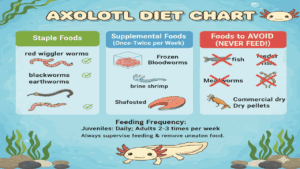Daily Pet Care Tasks for Kids (2025): Expert Tips on Age-Appropriate Routines, Cost-Saving Tools, and Common Mistakes to Avoid
Your dog’s wagging their tail, and your cat’s purring softly. That’s instant joy for the children. Your kids love them, and they probably love your kids, too. That said, you’ll need to teach your young ones how to properly take care of the animals besides using love.
Parents, we’re sure you’re wondering what daily pet care tasks for kids you can start implementing. After all, you don’t want to discourage the children. But you also really don’t want to deal with issues like spills, overfeeding, and other messes.
Remember, you’ll need to start with age-appropriate routines. If you have a preschooler, they should be capable of safely pouring pre-measured food for your pet. And you can also get them to help wipe the pets’ bowls.
Your older children, on the other hand, can help you brush the animal, but under your supervision, to be safe. They can even help track feeding schedules, so giving them a laminated chore chart is a good idea.
To reduce accidents, vet educators say that we should use kid-sized tools like spill-proof bowls or soft-bristle brushes when teaching our kids how to care for the animals. These extra few dollars of investment can really make a difference.
Also, don’t let your kid guess the food portions by themselves. You don’t want to deal with your animal pal becoming obese. Instead, give your kid a measuring scoop and teach them how to use it.
Now, let’s dive into this piece and see what more you can do to raise a responsible young caregiver.
The Science of Responsibility: How Pet Care Builds Your Child’s Brain
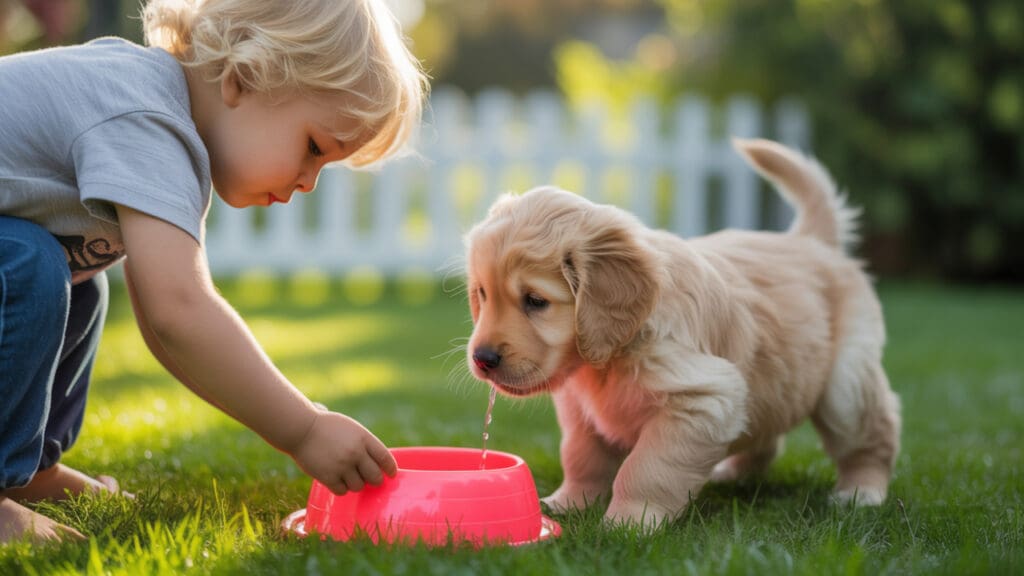
When your child feeds the family pet or gently brushes their fur, something remarkable is happening inside their developing brain. Pet care isn’t just about teaching responsibility-it actually strengthens the very neural pathways that shape attention, empathy, and decision-making for life.
Prefrontal Cortex Development: Your Child’s “Executive Manager”
The prefrontal cortex-the brain’s command center for planning, self-control, and decision-making-lights up during consistent routines like filling the water bowl or sticking to a feeding schedule. Each small act of care reinforces the neural connections responsible for executive function. Research shows children who interact with pets display stronger prefrontal activity, particularly when performing attention-heavy tasks. Over time, these routines help build the skills kids rely on for school, friendships, and problem-solving.
Empathy & Mirror Neurons: The Emotional Intelligence Link
The brain’s mirror neurons fire both when we act and when we watch someone else act. They’re the biological foundation of empathy. When a child notices a dog’s wagging tail or a cat’s flicking ears, their mirror neuron system activates-training their brain to recognize and respond to emotional cues. This practice transfers beyond pets, helping children tune into the feelings of friends, teachers, and family members with greater understanding.
What the Research Shows
According to Dr. Rachel Purewal’s comprehensive research published in PLOS ONE, “Pet ownership may facilitate cognitive development by providing opportunities to improve cognitive executive functions through stress reduction and social support”. Her studies found that children with pets show enhanced attention, memory, and problem-solving abilities compared to those without animal companions.
The most compelling evidence comes from recent neuroimaging studies. Research published in PLOS ONE demonstrates that “prefrontal brain activity increased with a rise in interactional closeness with a dog,” and this effect persists even after the interaction ends. In simple terms, the more hands-on care your child provides, the stronger their brain development becomes.
What Are Daily Pet Care Activities for Kids? Definitions and Safety Basics
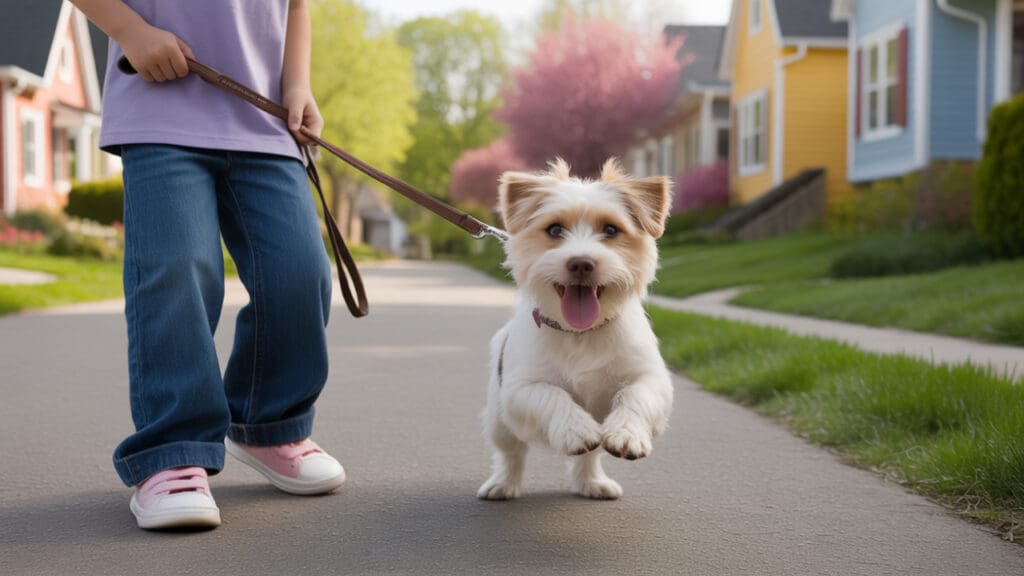
To put it simply, daily pet care tasks for kids are the small routines that your children can follow rather easily. These should be repeatable. And they are meant to keep your pet healthy and teach your kids about responsibility, empathy, and consistency.
You can teach your children how to feed the animals properly and provide them with fresh water. You can also teach them how to clean up after the pet. Besides that, you’ll need to guide them on how to groom the pet gently and play with them the right way.
First thing you need to remember, though, is that these activities shouldn’t be treated as chores in the conventional sense. You’re raising your kids to respect the animals and developing their discipline from caring for another living being.
Now, structure is what you need to succeed. You want your kids to do these every day, so don’t let them get confused. Make sure that the tasks are simple enough. And they should be clearly defined and age-appropriate.
Experts also say that we should start small and add more responsibilities gradually. Make a checklist for your kids to see their progress. The key is to keep them engaged so that they’ll continue to execute those tasks consistently.
Age-Appropriate Pet Care Activities for Preschoolers and Older Kids
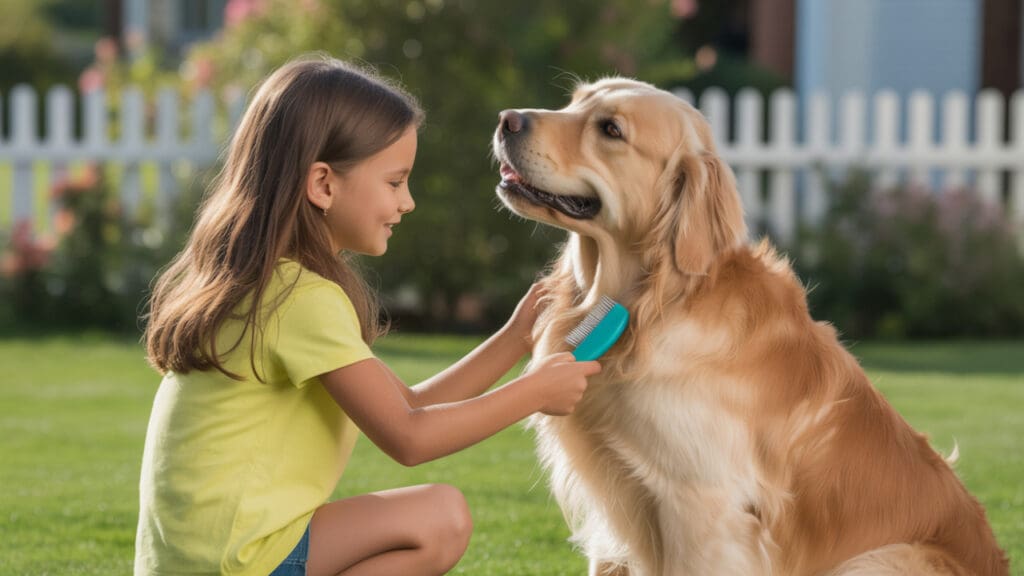
Your children, even the young ones, can certainly help you take care of the family pet. But you’ll definitely want to match their abilities to something age-appropriate. And when your kids successfully complete the tasks assigned to them, they will get some confidence boosts.
So, you have a preschooler, maybe around the ages of three to five? Then, you should know that they thrive on simple, supervised duties. Pet care for preschoolers should focus on observation and gentle interaction.
You can teach them how to pour pre-measured food into your pet’s dish. Let them help bring that grooming brush to you and guide them to place the toys back in the storage bin. These activities can develop their fine motor skills and teach them about cause-and-effect.
At this stage, don’t let them do tasks like litter box cleaning or handling heavy water containers. You should set a clear boundary. Something along the line of “look but don’t lift” will work. It can really help prevent accidents.
As for your older kids, perhaps those in elementary through preteens? They can take on something more complex. You can have them measure the food portions and track the feeding times on a chore chart. You can even let them start brushing the animal. Just make sure you supervise well.
For kids 10 and up, you can have them start cleaning your pet’s water bowl and help you take them out for walks. Vet educators say that these daily pet care tasks for kids can really help foster a sense of ownership and reduce behavioral issues in your pet.
Step-by-Step Daily Routines: Animal Care Activities for Kids by Task
Before you get your kids started on the tasks, remember that consistency is the backbone of pet care. To make sure that you don’t overwhelm your little ones, let’s break things down into clear and repeatable steps.
For mornings, teach your kid to start the day by refilling your pet’s water bowl. Guide them to check the water levels before breakfast. Also, tell them to use a lightweight pitcher or cup so that they can avoid spills.
This simple habit can help reinforce your child’s observation skills. And it really sets the tone for the rest of the day.
Next is feeding. You, as the parent, should start off by measuring the kibble or pellets for your kids first so that they know what the correct amount looks like. Don’t let them guess the portion, as this usually leads to overfeeding.
If your kid is old or responsible enough, you can introduce a measuring scoop and guide them to use it patiently. Let them know the consequences of underfeeding and overfeeding. This will only help them grow as a responsible caregiver.
After the meal, you’ll need to have your kid do a quick clean-up. Teach them how to wipe the animal’s bowl. A damp cloth or paper towel with warm, soapy water will suffice. Make sure they dispose of the leftover food and wash their hands to reduce germs and allergens.
For afternoon or evening routines, you should plan for some enrichment tasks. For example, have a supervised play session, let your kid brush the pet’s fur gently, or maybe you can even teach your kid how to use a puzzle feeder to help stimulate the animal’s mind.
These daily pet care tasks for kids are very much valuable bonding time. They teach your kids to be responsible, and your pet gets to enjoy their time with your children.
Beyond the Basics: Fostering Pet–Kid Bonding Through Enrichment
Once your child has feeding and grooming down, it’s time to unlock the fun side of pet care-enrichment activities. These not only strengthen the bond between kids and pets but also provide valuable mental stimulation for both.
DIY Puzzle Feeder Projects: Simple Engineering for Small Hands
A muffin tin, a few tennis balls, and kibble are all you need. Have your child:
- Place small portions of food in several muffin tin cups.
- Cover each cup with a tennis ball.
- Set the puzzle on the floor and let the pet work it out.
This teaches your child problem-solving skills while giving your pet a boredom-busting challenge. Pets that use puzzle feeders are shown to have lower stress and greater mental engagement.
Training Sessions: Building Confidence Together
Even young children can safely participate in teaching basic commands like “sit” or “stay” using positive reinforcement. With your supervision, let your child hold the treats and reward the pet immediately when the behavior is performed. This simple training builds trust, helps kids learn patience, and gives them firsthand practice in reading non-verbal cues-an essential skill for empathy.
Sensory Gardens for Small Pets: Care Meets Sustainability
If your family has rabbits, guinea pigs, or similar pets, consider creating a small herb garden together. Plant pet-safe herbs such as parsley, cilantro, or wheatgrass in pots. Your child can water and tend the plants, then harvest them as fresh food. This hands-on activity teaches responsibility, introduces sustainability concepts, and mirrors natural foraging behaviors that improve pet wellbeing.
Safe Pet Grooming Activities for Kids: Supervision and Tools
Now, let’s zoom in on grooming. We’re sure that your kid would love touching your family pet. And grooming is one way to keep the animal looking adorable and maintain cleanliness, thus their health.
So, let’s start with something with the least risk. You can have your kid brush the animal’s fur with a soft-bristle brush or gently wipe their paws after a walk. But you, the parent, should remain alert.
Guide your child’s movements whenever you deem necessary. Gentleness is the key. And teach your kid to read the animal’s body language. Is your dog wagging their tail fast? Or is your cat lying down in a relaxed manner? Let your kid know when to continue and when to back off.
You can further develop your kid’s observation skills by making the grooming session a mini health check challenge. Vet professionals say that we can have our children look for things like tangles, bumps, or fleas. This can also help us adults be wary of any possible treatment needs.
Naturally, you’ll need to buy some tools to help your kid out with the grooming process. Invest in something that’s kid-friendly. For example, you can buy a rounded-edge brush and lightweight grooming mitts. Getting some tear-free wipes can be a good idea, too.
These tools can help prevent accidents and make the grooming sessions more comfortable for your child and your pet. Remember, you shouldn’t let your kid use that adult-sized brush of yours on the animal. They might accidentally scratch the pet’s sensitive skin or create painful snags.
If you want to keep your child’s motivation level high, perhaps you could set up a grooming station for this activity. Have a non-slip mat in place and organize the supplies in labeled bins. You can even have your child personalize the grooming cloth or color-code the brushes.
Common Myths and Mistakes About Daily Pet Care Tasks for Kids
Perhaps you might have heard that caring for a pet is quite straightforward. But lots of myths out there just lead us astray. And that’s more so the case for children. So, let’s unravel these misconceptions so that you can proceed with the daily pet care tasks for kids safely.
First, most of us believe that our older children can manage waste-related tasks just fine without your oversight. Maybe you’re having them clean the animal’s litter box or handle their raw pet food. While it doesn’t seem like a big deal, you should know that these tasks also expose them to things like bacteria, parasites, and allergens.
Vet professionals say that we, the adults, should manage or supervise these duties closely. It doesn’t mean that you shouldn’t let your kid do them. It’s more about making sure that they’re handling things right consistently so that they themselves aren’t harmed in the process.
Another misconception is regarding small pets. Some people think that animals like hamsters or guinea pigs are “low maintenance,” so they must be ideal for children. Not really. You should know that your kid needs to clean their habit precisely. And they need to really watch their dietary needs, too. Your children will most likely get overwhelmed rather quickly.
The next thing families underestimate is the need for structured training. You shouldn’t assume that your child will “just know” how to do the chores. Brushing, feeding, and playing with the pet. These activities may seem intuitive to you, but that’s far from the case for a child who’s yet to experience much.
The last thing is tools. People think that their kids can just “learn to handle” the adult-sized tools. But the truth is, your kid is barely developed in their motor control. Without an appropriate tool, it’s easy for them to slip, feel frustrated, and cause some unintended accidents or injuries.
Checklists and Teaching Aids for Daily Pet Care Tasks for Kids
Now, let’s do a final check to see what equipment and useful aids could help your child succeed in their pet care attempts. These should help make the daily pet care tasks for kids safer, more engaging, and easier to sustain.
Let’s talk about the basics first. Number one, you should have a child-friendly grooming brush to help your kid handle the session without making clumsy slips.
Two, get them a lightweight scoop for measuring the pet food. Make sure you clearly tell your kid exactly how much food to give and check if they know how to measure the amount correctly.
Third, you need to buy a spill-proof stainless-steel bowl. Especially in the initial stage of learning, your child will stumble and make mistakes, not to mention your animal getting overly excited, too. These will likely cause a mess and might even discourage your little caregiver. The anti-spill measure can curb this challenge.
Moving on to teaching aids, you can try using a timer to help your kid stay on schedule. This should be especially helpful when they are first starting out. It’ll make sure they don’t miss any feeding time and likely teach them about time management.
Next, you can get some color-coded bins to help your child clean up or sort out any messes. For instance, tell them that the pink bin is for brushes and the blue one is for feeding supplies. This should help them be more organized.
Another thing is picture-based step cards for your younger children. These cards should provide them with visual cues (they likely can’t read yet) and should be numbered. You kids can then follow the instructions in the correct order.
FAQs on Daily Pet Care Activities for Kids
As parents, you probably have lots of questions about how your children can safely and effectively help take care of your family pets on a daily basis. Do not fret. Let’s take a look at some of the more frequently asked questions that could help you build a safe, rewarding routine for your kids.
1. How to teach kids to care for pets?
You should start with tasks that are short and supervised. Try something like pouring pre-measured food or brushing with a soft brush. Gradually, you can add responsibilities to your child’s plate. But make sure they are consistent and understand why they are doing them.
2. What can children learn from taking care of pets?
These activities can help your child develop empathy, patience, and responsibility. They also help your little ones gain insight into animal needs and daily routines that keep pets healthy.
3. What activities do pets like?
Most pets enjoy interactive play and gentle brushing. You can also introduce enrichment games such as puzzle feeders or outdoor exploration. Just make sure to supervise your kid.
4. How caring for animals teaches children responsibility?
If you let your kids engage in chores like checking water bowls or logging feeding times, it can help them understand the logic of cause and effect. This should also reinforce the importance of reliability.
5. What daily pet care tasks are safe for preschoolers?
You can have your preschooler hand over a brush and observe while you’re grooming the pet. They can also help tidy the toys and pour pre-measured kibble under your supervision. These activities can help build their confidence without risking injury.
6. Why is handwashing important after pet care?
Handwashing can prevent the spread of bacteria, allergens, and parasites. These can transfer from pets to children during routine care. So, hygiene is very important.
7. Can kids help with pet grooming?
Yes, gentle tasks like brushing or wiping paws are safe when you, the adult, supervise. You should not let your kid try nail trimming and bathing. These should remain adult-only duties.
8. How often should children help with pet care?
Small daily tasks such as feeding and refreshing water can keep your kids engaged. As for bigger jobs like deep cleaning, try to rotate weekly so that you can prevent them from feeling burned out.
9. What are common mistakes parents make when assigning pet care to kids?
Sometimes we give them unsupervised tasks too soon or skip kid-sized tools. It’s also a common thing to fail to set clear routines. These can lead to accidents, overfeeding, or missed feedings.
10. How can I motivate my child to stay consistent with pet care routines?
You can try using a sticker chart or timer to help your kids track tasks. To make it more personal, let them choose their own tools. Give praise or small rewards to keep them engaged.
Ready to Start Daily Pet Care with Confidence?
So, are you all set and ready to assign those daily pet care tasks for kids? This can be a cute project that helps your little one build empathy, responsibility, and safe habits that last a lifetime.
Just make sure that the tasks are age-appropriate. A preschooler shouldn’t be assigned to measure the pet’s food by themselves. Your older kids will still need your supervision while grooming your pet.
Remember, create structure and have your children stick to it consistently. They’ll likely be able to avoid mistakes like overfeeding or unsafe cleaning if you set things up right.
Now, take your first step in getting those routine tasks out. Know that you’re both nurturing your child and safeguarding your pet’s happiness at the same time.
Have you started letting your kid(s) take on some pet care responsibilities? What do they enjoy doing the most? Let us know in the comments down below!

